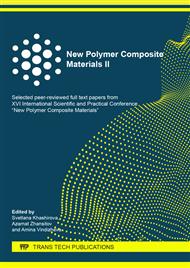[1]
D.A. Topchiev, Yu.A. Malkanduev, Cationic polyelectrolytes: production, properties and application, ICC «Akademkniga», Moscow, (2004).
Google Scholar
[2]
A.T. Djalilov, Yu.A. Malkanduev, A.K. Mikitaev, Synthesis and properties of reactive polymers, D. I. Mendeleev Russian Chemical-Technological University, Moscow, (2011).
Google Scholar
[3]
S.S. Dryabina, J.N. Malysheva, A.V. Navrotsky, I.A. Novakov, Regulation of the stability of aqueous dispersions by cationic polyelectrolytes, Bulletin of the Volgograd State Technical University. 12 (2019) 43-59.
Google Scholar
[4]
A.A. Kokoeva, M.B. Begieva, Yu.A. Malkanduev, M.A. Dokshukina, Conductometric method for determining the electrical conductivity of solutions of polyelectrolytes, Physico-chemical aspects of the study of clusters, nanostructures and nanomaterials. 11 (2019) 177-183.
DOI: 10.26456/pcascnn/2019.11.177
Google Scholar
[5]
L.D. Asulyan, O.A. Kamaeva, V.A. Arlyapov, V.A. Alferov, Obtaining stable receptor elements based on polyvinyl alcohol hydrogel to create a bpc biosensor, Bulletin of Tula State University. Natural Sciences. 1 (2016) 37-45.
Google Scholar
[6]
M.N. Gorbunova, A.I. Vorobyev, A.G. Tolstikov, Yu.B .Monakov, N-vinylpyrrolidone in radical copolymerization reactions, Review Izv. universities. Ser.: Chemistry and Chem. Technology. 49 (2006) 3-22.
Google Scholar
[7]
M.N. Gorbunova, E.A. Sazonova, Sorption activity of copolymers of N-vinylpyrrolidone with trimethoxyvinylsilane, Zhurnal Prikladnoi Khimii. 81 (2008) 1743-1744.
Google Scholar
[8]
A.A. Almova, M.B. Begieva, A.M. Charaev, N.A. Sivov, Yu.A. Malkanduev, N,N-diallylaminoethane acid and polymers based on it, News of higher educational institutions. North Caucasus region. Natural science. 3 (2012) 53-58.
Google Scholar
[9]
M.N. Gorbunova, The copolymerization of N-vinylpyrrolidone with new allyl monomers, Zhurnal Prikladnoi Khimii. 83 (2010) 1324-1329.
Google Scholar
[10]
N.A. Hadjiantoniou, C.S. Patrickios, Synthesis and characterization of amphiphilic conetworks based on multiblock copolymers, Polymer. 48 (2007) 7041.
DOI: 10.1016/j.polymer.2007.09.041
Google Scholar
[11]
G. Erdodi, J.P. Kennedy, Amphiphilic conetworks: Definition, synthesis, applications, Prog. Polym. Sci. 31 (2006) 1.
Google Scholar
[12]
C. Guerrero-Sanchez, D. Wouters, C.A. Fustin, J.F. Gohy, B.G. Lohmeijer, U.S. Shubert, Structure-Property Study of Diblock Copolymer Micelles: Core and Corona Radius with Varying Composition and Degree of Polymerization, Macromolecules. 38 (2005) 10185.
DOI: 10.1021/ma051544u
Google Scholar
[13]
Block copolymers in Nanoscience / Ed. by M. Lazzari, G. Liu, S. Lecommandoux, Wiley-VCH, Weinheim, (2006).
Google Scholar
[14]
M.N. Gorbunova, Synthesis of new biologically active polymer bioconjugates based on lupane allylamides, J. Chem. Pharm. Res. 5 (2013) 185-192.
Google Scholar
[15]
S.Yu. Khashirova, Yu.I. Musaev, Yu.A. Malkanduev, M.Kh. Ligidov, E.B. Musaeva, N.A. Sivov, A.K. Мikitaev, New hybrid nanocomposites based on layered aluminosilicates and ionogenic monomer/polymer acrylate and methacrylate guanidines, Nanotechnology. 3 (2009) 58-66.
DOI: 10.1134/s1560090409090085
Google Scholar
[16]
N.A. Sivov, Yu.A. Malkanduev, S.Yu. Khashirova, M.H. Baidaeva, A.I. Sarbasheva, A.A. Zhansitov, O.A. Taov, Biocide and toxicological properties of synthesized guanidine containing polymer and their structure, in: A.K. Mikitaev, M.K. Ligidov, G.E. Zaikov (Eds.), Modern Tendencies in Organic and Bioorganic Chemistry: Today and Tomorrow, New York, 2008. P. 335-340.
Google Scholar
[17]
M.B. Begieva, A.M. Charaev, Yu.A. Malkanduev, A.K. Мikitaev, R.Ch. Bazheva, А.А. Аlmova, N,N-diallylaminoethane acid and method of obtaining, Patent RU 2458045 C2 (2012).
Google Scholar
[18]
M.N. Gorbunova, A.I. Vorob'eva, A.G. Tolstikov, Yu.B. Monakov, New N‐allylated monomers in the synthesis of practical valuable high‐molecular‐weight compounds, Polymers for Advanced Technologies. 20 (2009) 209-215.
DOI: 10.1002/pat.1253
Google Scholar
[19]
T. Vardareli, S. Keskin, A. Usanmaz, Synthesis and Characterization of Poly(allyl methacrylate) Obtained by Free Radical Initiator, J. Macromol. Sci. A. 45 (2008) 302.
DOI: 10.1080/10601320701863783
Google Scholar


